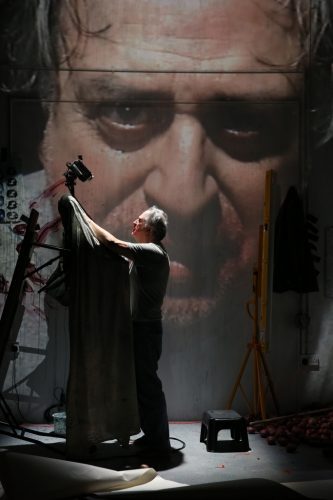
Stanley Townsend channels Joseph Beuys in one-man show by Paul Muldoon about his later partner, Mary Farl Powers (photo by Carol Rosegg)
Irish Repertory Theatre, Francis J. Greenburger Mainstage
132 West 22nd St. between Sixth & Seventh Aves.
Tuesday – Sunday through March 15, $50-$70
212-727-2737
irishrep.org
In 1992, influential printmaker Mary Farl Powers died of breast cancer at the age of forty-three. Shortly after, her partner, Irish poet Paul Muldoon, wrote Incantata, an exquisite long-form poem about the Minnesota-born artist, who spent most of her life in Ireland. Director Sam Yates and award-winning actor Stanley Townsend transformed Muldoon’s work into a wholly original sixty-minute one-man show that continues at the Irish Rep through March 15.
In the program, Muldoon recalls about writing the poem, “I was in the state of ecstasy in which almost all my poems are written — that’s to say I was standing outside myself in ‘mystic self-transcendence’ — but this particular state of ecstasy was somehow more pronounced than usual.” Yates and Townsend capture that ecstatic feeling throughout Incantata as Townsend whirls around the claustrophobic set, delivering Muldoon’s words at a glorious operatic scale, his voice deepening at certain moments, hitting you right in the gut.
Early on, he says, “I thought again of how art may be made, as it was by André Derain, / of nothing more than a turn in the road where a swallow dips into the mire / or plucks a strand of bloody wool from a strand of barbed wire / in the aftermath of Chickamauga or Culloden / and builds from pain, from misery, from a deep-seated hurt, / a monument to the human heart / that shines like a golden dome among roofs rain-glazed and leaden.” Like several stanzas, Townsend repeats it as he moves across Rosanna Vize’s set, a studio with three walls onto which he tapes sheets of paper he has imprinted with squiggly red images he creates using carved potatoes and dye, evoking Powers’s abstract “Emblements” etchings, which he refers to as “army-worms.” The stage represents Dublin’s Graphic Studio, where Powers was director for more than a decade. Potatoes are piled in one corner, a boombox plays cassettes, and Townsend, in a painter’s jumpsuit (his costumes are also by Vize), uses and repurposes a chair and table in Beuys-ian ways while often speaking directly into a camera on a tripod, as if it’s Powers herself. His face and body are projected onto the back wall, like he’s some kind of gigantic force; when he looks into the lens, his larger-than-life image is gazing straight at the audience, which can be imposing, especially as we decide whether to look at his cinematic image or his actual self. The video design is by Jack Phelan, with lighting by Paul Keogan and sound by Sinéad Diskin.
Muldoon’s (The Dead, 1904) structure was inspired by W. B. Yeats’s In Memory of Major Robert, which itself was influenced by Abraham Crowley’s seventeenth-century On the Death of Mr William Hervey, placing it firmly within the canon of Irish literary elegies. His writing also contains a tour-de-force of pop-culture, mythological, and historical references, from Van Morrison, Rembrandt, Burt Lancaster, Emily Post, Frankie Valli, Samuel Beckett, and Enrico Caruso to the Shirt of Nessus, Thomism, Lugh of the Long Arm, Dr. John Arbuthnot, Jean-Paul Sartre’s La Nausée, Brecht, and the Red Hand Commandos; please don’t Google them during the show (but you might want to afterward).
Townsend (All About Eve, Jerusalem) is extraordinary as he hunkers about the stage with an intense, intricately choreographed physicality; be sure to get to the theater early in order to watch him creating his art, which begins as soon as the doors open. He resembles a beguiling mix between William Kentridge, Christopher Hitchens, Gerard Depardieu, and Stephen Bannon, with piercing eyes and unkempt hair. Yates (The Starry Messenger, The Phlebotomist) illuminates the text with a keen understanding of its potency.
The late John Kelly, Powers’s predecessor as head of the Graphic Studio, said, “Mary Farl Powers never took an ordinary image. She always had a fantastic reason for making an image and the image gained from her intelligent approach. It set her aside. You’d see a real character behind the image. She had a very high technique, very high finish.” That description applies as well to this ingenious production of Incantata, an audacious, uncompromising elegy and love story poetically reimagined into a unique and unforgettable theatrical experience.